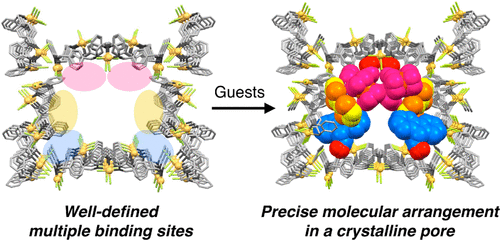当前位置:
X-MOL 学术
›
Acc. Chem. Res.
›
论文详情
Our official English website, www.x-mol.net, welcomes your feedback! (Note: you will need to create a separate account there.)
Novel Porous Crystals with Macrocycle-Based Well-Defined Molecular Recognition Sites.
Accounts of Chemical Research ( IF 18.3 ) Pub Date : 2020-01-23 , DOI: 10.1021/acs.accounts.9b00566 Shohei Tashiro 1 , Mitsuhiko Shionoya 1
Accounts of Chemical Research ( IF 18.3 ) Pub Date : 2020-01-23 , DOI: 10.1021/acs.accounts.9b00566 Shohei Tashiro 1 , Mitsuhiko Shionoya 1
Affiliation

|
Molecular recognition is one of the fundamental events in biological systems, as typified by enzymes that enable highly efficient and selective catalytic reactions through precise recognition of substrate(s) and cofactor(s) in the binding pockets. Chemists therefore have long been inspired by such excellent molecular systems to develop various synthetic receptors with well-defined binding sites. Their effort is currently being devoted to the construction of not only molecular receptors but also self-assembled host compounds possessing connected cavities (pores) in the crystalline frameworks to rationally design functional porous materials capable of efficiently adsorbing molecules or ions at binding sites on the pore walls. However, it is still challenging to design multiple distinct binding sites that are precisely arranged in an identical framework, which is currently one of the most important targets in this field to realize elaborate molecular systems beyond natural enzymes.In this Account, we provide an overview of porous crystals with well-defined molecular recognition sites. We first show several strategies for arranging macrocyclic binding sites in crystalline frameworks such as metal-organic frameworks, porous molecular crystals, and covalent organic frameworks. Porous metal-macrocycle frameworks (MMFs) that we have recently developed are then described as a new type of porous crystals with well-defined multiple distinct binding sites. The MMF-1 crystal, which was developed first and is composed of four stereoisomers of helical PdII3-macrocycle complexes, has one-dimensional channels with dimensions of 1.4 nm × 1.9 nm equipped with enantiomeric pairs of five distinct binding sites. This structural feature of MMF-1 therefore allows for site-selective and asymmetric arrangement of not only single but also multiple guest molecules in the crystalline channels based on molecular recognition between the guests and the multiple binding sites. This characteristic was also exploited to develop a heterogeneous catalyst by non-covalently immobilizing an organic acid on the pore surface of MMF-1 to conduct size-specific catalytic reactions. In addition, adsorption of a photoreactive substrate in MMF was found to switch the photoreaction pathway to cause another reaction with the aid of photoactivated PdII centers arranged on the pore walls. Furthermore, the dynamic, transient process of molecular arrangement incorporated in MMF-1 has been successfully visualized by single-crystal X-ray diffraction analysis. The formation of homochiral MMF-2 composed of only (P)- or (M)-helical PdII3-macrocycle complexes is also described. Thus, macrocycle-based porous crystals with a complex structure such as MMFs are expected to serve as novel porous materials that have great potential to mimic or surpass enzymes by utilizing well-defined multiple binding sites capable of spatially arranging a catalyst, substrate, and effector for highly selective and allosterically tunable catalytic reactions, which can be also visualized by crystallographic analysis because of their crystalline nature.
中文翻译:

具有基于大环的定义明确的分子识别位点的新型多孔晶体。
分子识别是生物系统中的基本事件之一,以酶为代表的酶可以通过精确识别结合口袋中的底物和辅因子来实现高效和选择性的催化反应。因此,化学家们长期以来一直受到如此出色的分子系统的启发,开发出具有明确结合位点的各种合成受体。他们目前的工作不仅用于构建分子受体,还用于构建在晶体框架内具有连通孔(孔)的自组装主体化合物,以合理设计能够有效吸附分子或离子在孔隙结合位点上的功能性多孔材料。墙壁。然而,设计在同一框架中精确排列的多个不同的结合位点仍然是一项挑战,这是目前实现超越天然酶的复杂分子系统的这一领域最重要的目标。具有明确的分子识别位点的晶体。我们首先显示几种在晶体框架(例如金属有机框架,多孔分子晶体和共价有机框架)中排列大环结合位点的策略。我们最近开发的多孔金属宏环骨架(MMF)被描述为一种新型的多孔晶体,具有明确定义的多个不同的结合位点。MMF-1晶体是最早开发的,由四个螺旋PdII3-大环复合物的立体异构体组成,具有尺寸为1.4 nm×1.9 nm的一维通道,配有五个不同结合位点的对映体对。因此,MMF-1的这种结构特征允许基于客体和多个结合位点之间的分子识别,在结晶通道中不仅单个而且多个客体分子进行位点选择和不对称排列。通过将有机酸非共价固定在MMF-1的孔表面上以进行特定尺寸的催化反应,还可以利用该特性开发多相催化剂。另外,发现在MMF中光反应性底物的吸附通过设置在孔壁上的光活化的PdII中心来切换光反应路径以引起另一反应。此外,动态 通过单晶X射线衍射分析已成功可视化了MMF-1中包含的分子排列的瞬时过程。还描述了仅由(P)-或(M)-螺旋的PdII3-大环复合物组成的同手性MMF-2的形成。因此,具有复杂结构的基于大环的多孔晶体,例如MMF,有望通过利用能够在空间上排列催化剂,底物和效应子的明确定义的多个结合位点,成为具有巨大潜力来模仿或超越酶的新型多孔材料。用于高度选择性和变构可调的催化反应,由于其晶体性质,也可以通过晶体学分析将其可视化。还描述了仅由(P)-或(M)-螺旋的PdII3-大环复合物组成的同手性MMF-2的形成。因此,具有复杂结构的基于大环的多孔晶体,例如MMF,有望通过利用能够在空间上排列催化剂,底物和效应子的明确定义的多个结合位点,成为具有巨大潜力来模仿或超越酶的新型多孔材料。用于高度选择性和变构可调的催化反应,由于其晶体性质,也可以通过晶体学分析将其可视化。还描述了仅由(P)-或(M)-螺旋的PdII3-大环复合物组成的同手性MMF-2的形成。因此,具有复杂结构的基于大环的多孔晶体,例如MMF,有望通过利用能够在空间上排列催化剂,底物和效应子的明确定义的多个结合位点,成为具有巨大潜力来模仿或超越酶的新型多孔材料。用于高度选择性和变构可调的催化反应,由于其晶体性质,也可以通过晶体学分析将其可视化。
更新日期:2020-01-23
中文翻译:

具有基于大环的定义明确的分子识别位点的新型多孔晶体。
分子识别是生物系统中的基本事件之一,以酶为代表的酶可以通过精确识别结合口袋中的底物和辅因子来实现高效和选择性的催化反应。因此,化学家们长期以来一直受到如此出色的分子系统的启发,开发出具有明确结合位点的各种合成受体。他们目前的工作不仅用于构建分子受体,还用于构建在晶体框架内具有连通孔(孔)的自组装主体化合物,以合理设计能够有效吸附分子或离子在孔隙结合位点上的功能性多孔材料。墙壁。然而,设计在同一框架中精确排列的多个不同的结合位点仍然是一项挑战,这是目前实现超越天然酶的复杂分子系统的这一领域最重要的目标。具有明确的分子识别位点的晶体。我们首先显示几种在晶体框架(例如金属有机框架,多孔分子晶体和共价有机框架)中排列大环结合位点的策略。我们最近开发的多孔金属宏环骨架(MMF)被描述为一种新型的多孔晶体,具有明确定义的多个不同的结合位点。MMF-1晶体是最早开发的,由四个螺旋PdII3-大环复合物的立体异构体组成,具有尺寸为1.4 nm×1.9 nm的一维通道,配有五个不同结合位点的对映体对。因此,MMF-1的这种结构特征允许基于客体和多个结合位点之间的分子识别,在结晶通道中不仅单个而且多个客体分子进行位点选择和不对称排列。通过将有机酸非共价固定在MMF-1的孔表面上以进行特定尺寸的催化反应,还可以利用该特性开发多相催化剂。另外,发现在MMF中光反应性底物的吸附通过设置在孔壁上的光活化的PdII中心来切换光反应路径以引起另一反应。此外,动态 通过单晶X射线衍射分析已成功可视化了MMF-1中包含的分子排列的瞬时过程。还描述了仅由(P)-或(M)-螺旋的PdII3-大环复合物组成的同手性MMF-2的形成。因此,具有复杂结构的基于大环的多孔晶体,例如MMF,有望通过利用能够在空间上排列催化剂,底物和效应子的明确定义的多个结合位点,成为具有巨大潜力来模仿或超越酶的新型多孔材料。用于高度选择性和变构可调的催化反应,由于其晶体性质,也可以通过晶体学分析将其可视化。还描述了仅由(P)-或(M)-螺旋的PdII3-大环复合物组成的同手性MMF-2的形成。因此,具有复杂结构的基于大环的多孔晶体,例如MMF,有望通过利用能够在空间上排列催化剂,底物和效应子的明确定义的多个结合位点,成为具有巨大潜力来模仿或超越酶的新型多孔材料。用于高度选择性和变构可调的催化反应,由于其晶体性质,也可以通过晶体学分析将其可视化。还描述了仅由(P)-或(M)-螺旋的PdII3-大环复合物组成的同手性MMF-2的形成。因此,具有复杂结构的基于大环的多孔晶体,例如MMF,有望通过利用能够在空间上排列催化剂,底物和效应子的明确定义的多个结合位点,成为具有巨大潜力来模仿或超越酶的新型多孔材料。用于高度选择性和变构可调的催化反应,由于其晶体性质,也可以通过晶体学分析将其可视化。


























 京公网安备 11010802027423号
京公网安备 11010802027423号